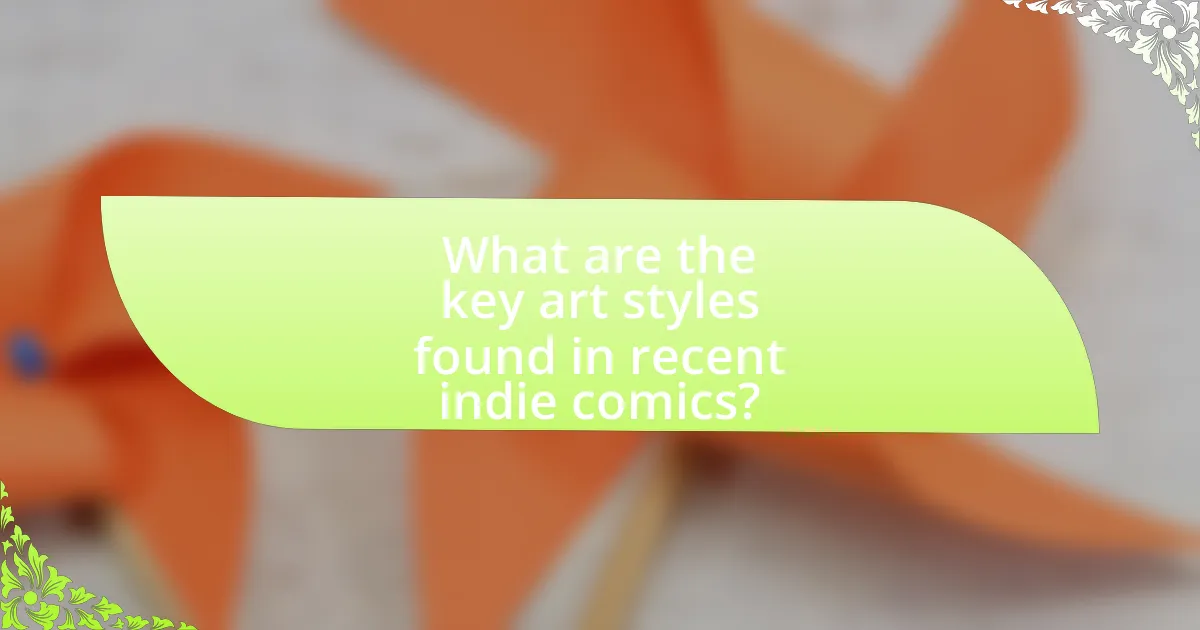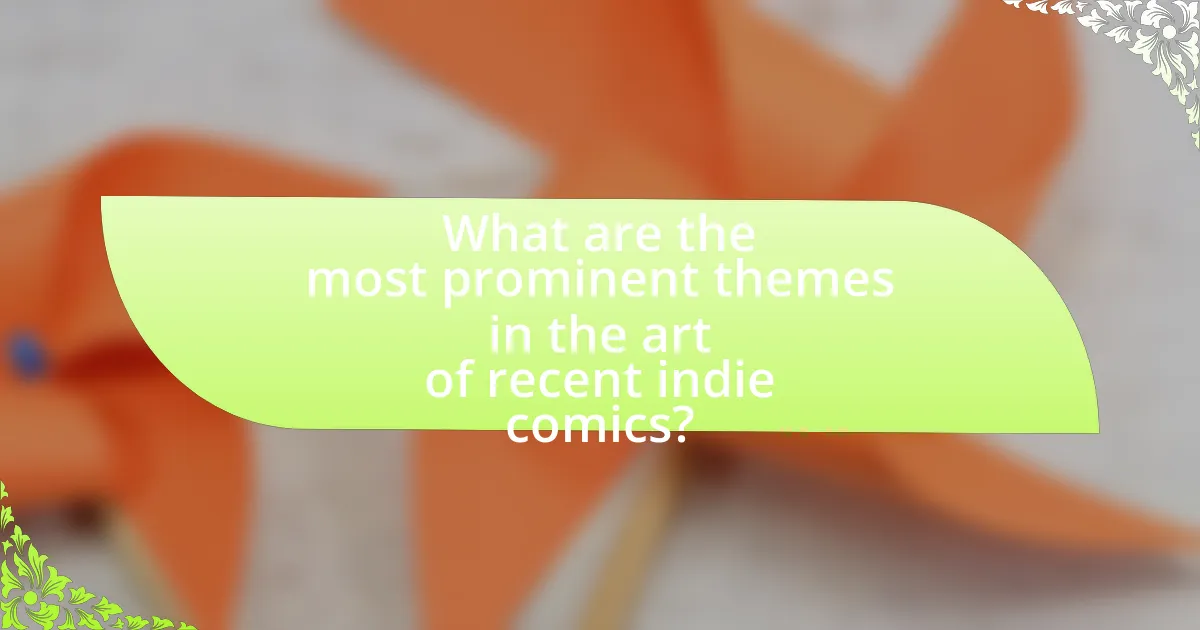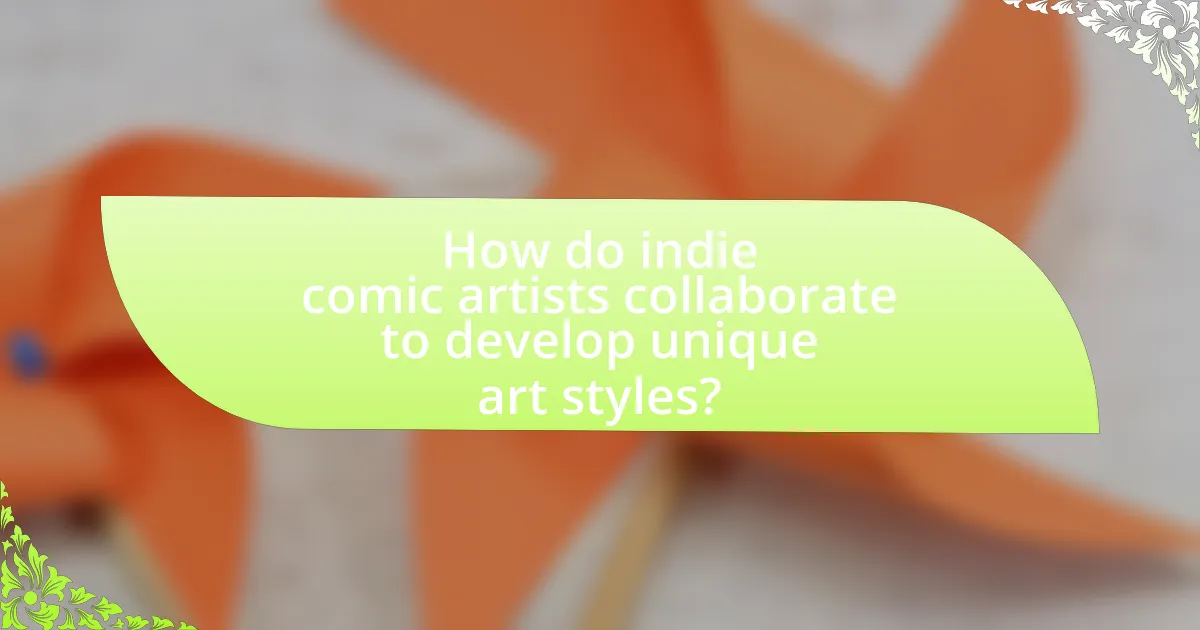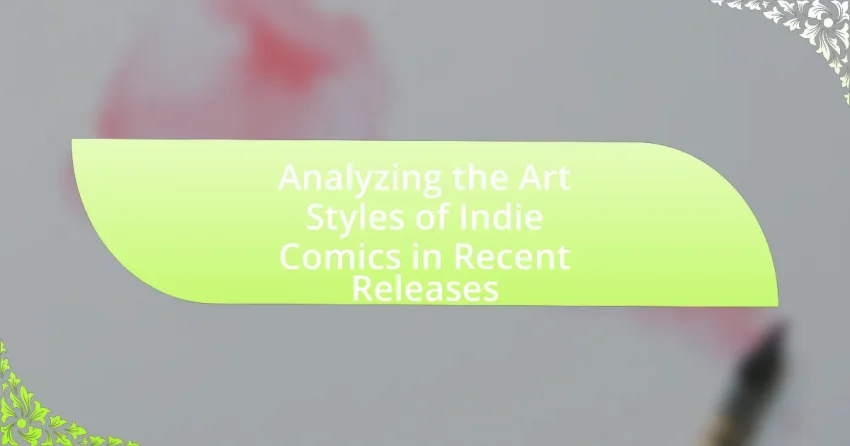The article analyzes the diverse art styles found in recent indie comics, highlighting key trends such as minimalism, surrealism, and retro aesthetics. It examines how these styles differ from mainstream comic art, emphasizing the unique techniques and individual expressions of indie artists. The discussion includes the influence of cultural trends on visual storytelling, the prominent themes explored in indie comics, and the collaborative processes that shape their art styles. Additionally, it addresses the challenges indie artists face in establishing their identities and gaining visibility, while providing best practices for refining their craft.

What are the key art styles found in recent indie comics?
Recent indie comics prominently feature key art styles such as minimalism, surrealism, and retro aesthetics. Minimalism is characterized by clean lines and sparse detail, allowing the narrative to take center stage, as seen in works like “The Arrival” by Shaun Tan. Surrealism often incorporates dream-like imagery and unconventional layouts, exemplified in comics like “Clyde Fans” by Seth, which blends reality with fantastical elements. Retro aesthetics draw inspiration from vintage comic styles, utilizing bold colors and classic panel layouts, as demonstrated in “Isola” by Brenden Fletcher and Karl Kerschl. These styles reflect the diverse creative approaches within the indie comic scene, showcasing innovation and artistic expression.
How do these art styles differ from mainstream comic art?
Indie comic art styles differ from mainstream comic art primarily in their emphasis on unique, experimental aesthetics and storytelling techniques. While mainstream comics often adhere to established visual conventions and formulas for character design and narrative structure, indie comics frequently explore diverse artistic expressions, such as abstract forms, unconventional color palettes, and varied line work. For instance, indie artists like Daniel Clowes and Chris Ware utilize minimalist styles and intricate layouts that challenge traditional comic formats, contrasting with the more uniform and commercialized approaches seen in superhero comics. This divergence allows indie comics to convey more personal and nuanced themes, reflecting the individual artist’s vision rather than a corporate mandate.
What unique techniques are employed in indie comic art styles?
Indie comic art styles employ unique techniques such as unconventional panel layouts, mixed media, and distinctive color palettes. These techniques allow artists to express individuality and narrative in innovative ways. For instance, unconventional panel layouts can create dynamic storytelling, as seen in works like “Scott Pilgrim” by Bryan Lee O’Malley, where the arrangement of panels enhances the pacing and emotional impact. Mixed media, often incorporating elements like collage or digital art, adds texture and depth, exemplified in “The Arrival” by Shaun Tan, which uses illustrations alongside visual storytelling to convey complex themes. Additionally, indie comics frequently utilize distinctive color palettes that reflect the tone and mood of the story, as demonstrated in “Saga” by Brian K. Vaughan and Fiona Staples, where vibrant colors are used to differentiate between various worlds and characters. These techniques collectively contribute to the unique identity of indie comics, setting them apart from mainstream comic art.
How do indie artists express their individuality through art styles?
Indie artists express their individuality through diverse and unique art styles that reflect personal experiences and cultural influences. By utilizing unconventional techniques, such as mixed media, hand-drawn illustrations, and experimental layouts, these artists create distinctive visual narratives that set their work apart from mainstream comics. For instance, the use of vibrant color palettes or abstract forms can convey specific emotions or themes, allowing artists to communicate their personal perspectives effectively. This approach not only showcases their artistic voice but also resonates with audiences seeking authenticity and originality in storytelling.
Why is the evolution of art styles significant in indie comics?
The evolution of art styles is significant in indie comics because it reflects the diverse voices and innovative storytelling approaches within the medium. Indie comics often challenge mainstream conventions, allowing artists to experiment with unique visual styles that resonate with personal narratives and cultural themes. For instance, the rise of digital art tools has enabled creators to blend traditional techniques with modern aesthetics, resulting in a broader range of artistic expression. This evolution not only enhances the visual appeal of indie comics but also fosters a sense of community among creators and readers who appreciate the distinctiveness of these works.
What historical influences have shaped current indie comic art styles?
Current indie comic art styles have been shaped by historical influences such as the underground comix movement of the 1960s and 1970s, which emphasized personal expression and countercultural themes. This movement introduced a diverse range of artistic styles, breaking away from mainstream comic conventions and allowing for experimentation with form and content. Additionally, the influence of alternative art movements, such as Dadaism and Surrealism, has encouraged indie artists to incorporate unconventional imagery and narrative structures. The rise of digital technology in the 2000s further democratized comic creation, enabling artists to explore new techniques and reach wider audiences. These historical influences collectively contribute to the unique and varied aesthetics found in contemporary indie comics.
How do cultural trends impact the visual storytelling in indie comics?
Cultural trends significantly influence visual storytelling in indie comics by shaping themes, character designs, and narrative styles. For instance, the rise of social movements such as Black Lives Matter and LGBTQ+ rights has led indie comics to incorporate diverse characters and stories that reflect these societal changes. This shift is evident in works like “Moonlight” by Jenkins and “The Prince and the Dressmaker” by Jen Wang, which showcase representation and inclusivity. Additionally, the popularity of digital platforms has encouraged artists to experiment with unique art styles and formats, allowing for innovative storytelling techniques that resonate with contemporary audiences. These adaptations demonstrate how cultural contexts directly inform the visual language and thematic depth of indie comics.

What are the most prominent themes in the art of recent indie comics?
The most prominent themes in the art of recent indie comics include identity exploration, social justice, and mental health. Identity exploration is often depicted through diverse characters and personal narratives, reflecting the complexities of race, gender, and sexuality. Social justice themes are illustrated through visual storytelling that critiques societal norms and advocates for change, as seen in works addressing systemic inequality. Mental health is frequently represented through unique artistic styles that convey emotional experiences, allowing readers to engage with the subject matter on a personal level. These themes are supported by the increasing diversity of creators in the indie comic scene, which has led to a broader range of perspectives and stories being told.
How do themes influence the choice of art style in indie comics?
Themes significantly influence the choice of art style in indie comics by dictating the visual language that best conveys the narrative and emotional tone. For instance, a comic exploring themes of horror may adopt a darker, more chaotic art style with heavy shadows and distorted figures to evoke fear, while a story centered on whimsy or nostalgia might utilize bright colors and softer lines to create a sense of warmth and playfulness. This alignment between theme and art style enhances the reader’s experience, as evidenced by works like “Scott Pilgrim” by Bryan Lee O’Malley, which employs a vibrant, cartoonish style to complement its themes of youth and relationships. Such choices are not arbitrary; they are strategic decisions made by creators to ensure that the visual representation resonates with the underlying message of the story.
What themes are commonly explored through visual elements in indie comics?
Indie comics commonly explore themes such as identity, mental health, social justice, and personal relationships through their visual elements. These themes are often depicted using unique art styles, color palettes, and visual storytelling techniques that reflect the emotional depth and complexity of the narratives. For instance, the use of muted colors may symbolize feelings of isolation or depression, while vibrant illustrations can convey joy or community. This approach allows indie comics to resonate with readers on a personal level, making the themes more impactful and relatable.
How do artists use color and composition to convey themes?
Artists use color and composition to convey themes by strategically selecting hues and arranging visual elements to evoke specific emotions and narratives. For instance, warm colors like red and orange can signify passion or aggression, while cool colors such as blue and green often represent calmness or sadness. The composition, including the placement of characters and objects, guides the viewer’s eye and emphasizes focal points that align with the intended message. In indie comics, artists frequently employ these techniques to reflect themes such as isolation or community, as seen in works like “Saga” by Brian K. Vaughan and Fiona Staples, where color palettes shift to mirror character emotions and plot developments. This deliberate use of color and composition not only enhances storytelling but also deepens the reader’s engagement with the themes presented.
What role does audience perception play in the art styles of indie comics?
Audience perception significantly influences the art styles of indie comics by shaping creators’ choices to align with reader expectations and preferences. Indie comic artists often experiment with diverse visual styles, but they must consider how their work will be received by their target audience to ensure engagement and marketability. For instance, a study by the University of Dundee found that indie comics that resonate with audience aesthetics tend to achieve higher sales and reader retention, demonstrating the direct correlation between audience perception and artistic direction. This feedback loop encourages artists to adapt their styles, balancing personal expression with audience appeal to foster a successful connection with readers.
How do readers respond to different art styles in indie comics?
Readers respond to different art styles in indie comics with varied levels of engagement and preference, often influenced by personal taste and the emotional resonance of the artwork. For instance, research indicates that unique and unconventional art styles can attract readers seeking originality, while more traditional styles may appeal to those who prefer familiarity and clarity in storytelling. A study published in the Journal of Graphic Novels and Comics found that 67% of readers expressed a preference for distinctive art styles that enhance narrative depth, demonstrating that art style significantly impacts reader enjoyment and connection to the story.
What feedback mechanisms exist for indie artists regarding their art styles?
Indie artists receive feedback on their art styles through various mechanisms, including social media platforms, online art communities, critique groups, and art festivals. Social media platforms like Instagram and Twitter allow artists to share their work and receive immediate reactions from followers, fostering direct engagement. Online art communities, such as DeviantArt and ArtStation, provide spaces for artists to post their work and receive constructive criticism from peers. Critique groups, both in-person and virtual, offer structured environments where artists can present their work and receive detailed feedback from fellow artists. Additionally, art festivals and conventions often feature portfolio reviews, where industry professionals provide insights and critiques, helping indie artists refine their styles based on expert opinions. These mechanisms collectively enhance the artistic development of indie creators by facilitating diverse feedback.

How do indie comic artists collaborate to develop unique art styles?
Indie comic artists collaborate to develop unique art styles through shared creative processes, feedback loops, and cross-pollination of ideas. This collaboration often occurs in artist collectives or online platforms where artists exchange techniques, styles, and inspirations. For instance, many indie artists participate in workshops or conventions, allowing them to showcase their work and receive constructive criticism, which fosters innovation in their art styles. Additionally, collaborative projects, such as anthologies, enable artists to blend their distinct styles, resulting in a unique visual narrative that reflects diverse influences. This collaborative environment is supported by the indie comic community’s emphasis on experimentation and individuality, leading to the emergence of fresh and distinctive art styles.
What collaborative processes are common among indie comic creators?
Indie comic creators commonly engage in collaborative processes such as co-writing, shared art responsibilities, and peer feedback sessions. Co-writing allows multiple creators to contribute to the narrative, enhancing creativity and depth. Shared art responsibilities often involve artists collaborating on different aspects, such as one focusing on character design while another handles backgrounds, which can lead to a more diverse visual style. Peer feedback sessions are also prevalent, where creators share their work with each other for constructive criticism, fostering improvement and innovation. These collaborative methods are essential in indie comics, as they leverage the strengths of various creators to produce unique and compelling works.
How do partnerships influence the final art style of a comic?
Partnerships significantly influence the final art style of a comic by merging the distinct artistic visions and techniques of the collaborators. When writers and artists collaborate, their combined creativity can lead to innovative visual storytelling that reflects both their individual styles and a cohesive aesthetic. For instance, in indie comics, partnerships often result in unique art styles that deviate from mainstream trends, as seen in works like “Saga” by Brian K. Vaughan and Fiona Staples, where Staples’ distinct character designs and color palettes complement Vaughan’s narrative style, creating a unified artistic experience. This synergy not only enhances the visual appeal but also deepens the emotional resonance of the story, demonstrating how collaborative efforts shape the overall artistic direction of comic projects.
What are the benefits of collaboration in indie comic art creation?
Collaboration in indie comic art creation enhances creativity, skill diversity, and resource sharing. By working together, artists can combine their unique styles and perspectives, leading to innovative storytelling and visual techniques that may not emerge in solo projects. For instance, a writer and an illustrator collaborating can create a more cohesive narrative and visual experience, as seen in successful indie comics like “Scott Pilgrim” by Bryan Lee O’Malley, where the synergy between writing and art significantly contributed to its popularity. Additionally, collaboration allows for the pooling of resources, such as funding and marketing efforts, which can increase the project’s reach and impact in a competitive market.
What are the challenges faced by indie artists in establishing their art styles?
Indie artists face several challenges in establishing their art styles, primarily due to limited resources, market saturation, and the struggle for visibility. Limited financial support restricts access to quality materials and professional development opportunities, making it difficult for artists to refine their unique styles. Market saturation presents another challenge, as the abundance of indie comics can dilute individual voices, leading to difficulties in standing out. Additionally, the struggle for visibility in a crowded marketplace often forces artists to conform to popular trends rather than fully exploring their artistic identities. These factors collectively hinder indie artists from confidently establishing and promoting their distinctive art styles.
How do budget constraints affect artistic choices in indie comics?
Budget constraints significantly limit the artistic choices available to creators of indie comics. These financial limitations often force artists to prioritize essential elements, such as story and character development, over elaborate artwork or high-quality printing techniques. For instance, many indie comics utilize simpler art styles or fewer colors to reduce production costs, which can lead to a more stylized or minimalist aesthetic. Additionally, creators may opt for digital tools that are less expensive than traditional materials, impacting the overall visual presentation. This trend is evident in successful indie titles like “Scott Pilgrim” by Bryan Lee O’Malley, where the art style reflects both budgetary constraints and a unique narrative voice, demonstrating how financial limitations can shape creative expression.
What obstacles do indie artists encounter in gaining visibility for their art styles?
Indie artists encounter several obstacles in gaining visibility for their art styles, primarily due to limited marketing resources and competition from established creators. Many indie artists lack the financial backing to invest in promotional activities, which restricts their ability to reach wider audiences. Additionally, the saturation of the market with numerous artists and styles makes it challenging for individual creators to stand out. According to a survey by the Comic Book Legal Defense Fund, 70% of indie creators reported difficulties in marketing their work effectively, highlighting the systemic barriers they face in gaining recognition.
What best practices can indie comic artists follow to refine their art styles?
Indie comic artists can refine their art styles by consistently practicing their craft, studying various artistic techniques, and seeking constructive feedback. Regular practice allows artists to develop their skills and experiment with different styles, while studying techniques from established artists can provide insights into effective methods and approaches. Additionally, obtaining feedback from peers or mentors helps identify strengths and areas for improvement, fostering growth and refinement in their artistic expression.
How can artists effectively experiment with different techniques and styles?
Artists can effectively experiment with different techniques and styles by engaging in regular practice, studying diverse art forms, and collaborating with other artists. Regular practice allows artists to refine their skills and discover new methods, while studying various art forms exposes them to different techniques and perspectives. Collaboration with other artists fosters an exchange of ideas and techniques, encouraging innovation. Research indicates that artists who diversify their influences and actively seek feedback tend to develop a more versatile skill set, enhancing their ability to experiment successfully.
What resources are available for indie artists to improve their craft?
Indie artists can improve their craft through various resources, including online courses, workshops, and community platforms. Online platforms like Skillshare and Udemy offer courses specifically tailored to art techniques and storytelling for comics, allowing artists to learn from industry professionals. Workshops hosted by organizations such as the Society of Children’s Book Writers and Illustrators provide hands-on experience and networking opportunities. Additionally, community platforms like DeviantArt and ArtStation enable artists to share their work, receive feedback, and engage with other creators, fostering growth and collaboration. These resources collectively enhance skills and knowledge essential for indie artists in the comic industry.
